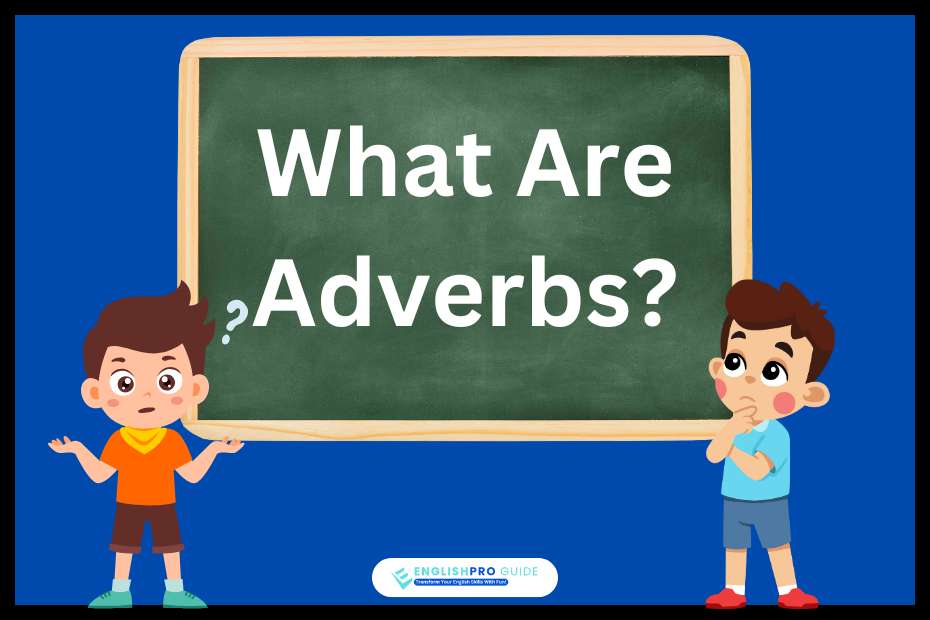Discover the World of Adverbs: Types and Usage Guide
Adverbs are words that modify verbs, adjectives, or other adverbs. They provide extra detail, answering questions like how, when, where, why, or to what extent.
Adverbs are integral to the English language, enhancing the meaning of verbs, adjectives, and other adverbs.
They provide details about how, when, where, why, or to what extent actions are performed, enriching communication and adding precision.
This guide explores various categories of adverbs, offering definitions, examples, and insights into their usage.
What Are Adverbs?

Adverbs are words that modify verbs, adjectives, or other adverbs. They provide extra detail, answering questions like how, when, where, why, or to what extent.
Adverbs modify verbs, adjectives, or other adverbs, often answering questions like:
- How? (He runs quickly.)
- When? (She will arrive soon.)
- Where? (The children are playing outside.)
- Why? (She studies because she loves learning.)
- To what extent? (He was extremely happy.)
This guide categorizes adverbs into their functional types for better understanding.
1. Adverbs of Degree
Adverbs of degree describe the intensity or extent of an action, adjective, or another adverb. They help quantify or emphasize the level of something.
Examples of Adverbs of Degree
- High degree: very, extremely, absolutely, completely
- She is very talented.
- He was completely unaware of the situation.
- Moderate degree: fairly, somewhat, quite
- The movie was quite enjoyable.
- Low degree: hardly, barely, slightly, almost
- He was barely able to lift the box.
Usage Notes
- Adverbs of degree often modify adjectives or other adverbs.
- The test was too difficult for beginners.
- They can also modify verbs:
- She barely noticed the changes.
2. Adverbs of Purpose
Adverbs of purpose (or adverbs of reason) explain why an action occurs. They provide the rationale or intent behind an activity or event.
Examples of Adverbs of Purpose
- Why?: so, therefore, hence, consequently, because
- She studied hard, so she passed the exam.
- He was late; therefore, he missed the meeting.
- Intent: to, for, in order to
- He left early to catch the train.
- She practiced daily in order to improve her skills.
Key Insights
- These adverbs often link clauses, making them vital for logical progression in writing.
- They frequently appear in formal contexts to clarify causation.
Read More: 160 Sentences With The Word Go And Going
3. Adverbs of Reason
Closely related to adverbs of purpose, adverbs of reason specifically address the cause of an action or event.
Examples of Adverbs of Reason
- Because of: He couldn’t attend because of the weather.
- Since: She stayed home since she was unwell.
- As: He left early, as he had a prior engagement.
- For this reason: The policy was revised for this reason.
Usage Notes
- These adverbs establish a cause-effect relationship, often serving as transitions in academic or formal writing.
- Pair them with conjunctions or prepositions for clear expression.
4. Adverbs of Frequency
Adverbs of frequency indicate how often an action occurs. They help express habits, routines, or the likelihood of events.
Types of Adverbs of Frequency
- Definite frequency: daily, weekly, annually
- She visits her grandparents weekly.
- Indefinite frequency: always, often, sometimes, rarely, never
- He always drinks coffee in the morning.
Placement Rules
- With main verbs:
- She often goes to the gym.
- With auxiliary verbs:
- He has never traveled abroad.
Key Tip
Adverbs of frequency typically appear before the main verb or after the verb “to be.”
5. Adverbs of Certainty
Adverbs of certainty express confidence, doubt, or probability about an action or event.
Examples of Adverbs of Certainty
- High certainty: definitely, certainly, surely, undoubtedly
- He is definitely coming to the party.
- Moderate certainty: probably, possibly, perhaps, likely
- She will probably arrive late.
- Low certainty: maybe, conceivably
- It might possibly rain tomorrow.
Usage Context
- These adverbs emphasize conviction or introduce hypothetical scenarios.
- The project will surely succeed if we all contribute.
Read More: 30 Example Sentence With The Word Their
6. Adverbs of Time
Adverbs of time specify when an action occurs, its duration, or its frequency.
Examples of Adverbs of Time
- When?: now, then, yesterday, tomorrow
- We’ll start the meeting now.
- Duration: forever, temporarily, always, never
- She’ll stay temporarily in the guesthouse.
- Sequence: first, next, afterwards, finally
- We’ll visit the museum first, then have lunch.
Placement Tips
- These adverbs usually appear at the beginning or end of a sentence for emphasis.
- Yesterday, we went to the park.
- We’ll meet again tomorrow.
7. Adverbs of Place
Adverbs of place indicate the location or direction of an action, answering the question “Where?”
Examples of Adverbs of Place
- Location: here, there, everywhere, somewhere
- She left her bag here.
- Direction: up, down, inside, outside, backward, forward
- The ball rolled down the hill.
- Proximity: nearby, far away, close by
- There’s a café nearby.
Usage Tips
- Adverbs of place follow the verb or object they modify.
- He looked outside for his dog.
Common Challenges with Adverbs
Adverbs enhance communication but pose challenges in placement, clarity, and overuse.
Key Issues
- Overuse of -ly Adverbs
- Adverbs ending in -ly (quickly, easily, happily) are often overused, making writing verbose.
- Example: He ran quickly → He sprinted.
- Ambiguous Placement
- Misplaced adverbs can alter meaning.
- Example: Only she loves chocolate. vs. She loves only chocolate.
- Mixing Adverbs and Adjectives
- Adverbs modify actions, while adjectives modify nouns.
- Incorrect: She speaks beautiful. → Correct: She speaks beautifully.
Mastering Adverbs: Tips for Learners
- Read and Observe: Pay attention to adverb usage in books, articles, and conversations.
- Practice Concision: Use adverbs sparingly to avoid redundancy.
- Understand Context: Differentiate between similar categories, such as time and frequency.
- Experiment with Placement: Test sentence flow by repositioning adverbs.
Conclusion
Adverbs are a powerful tool in English, providing depth and clarity to language.
By understanding the nuances of adverbs of degree, purpose, reason, frequency, certainty, time, and place, you can craft precise and engaging communication.
Whether writing a story, delivering a speech, or drafting a formal document, mastering adverbs will elevate your linguistic skills, helping you convey your message effectively and with impact.






